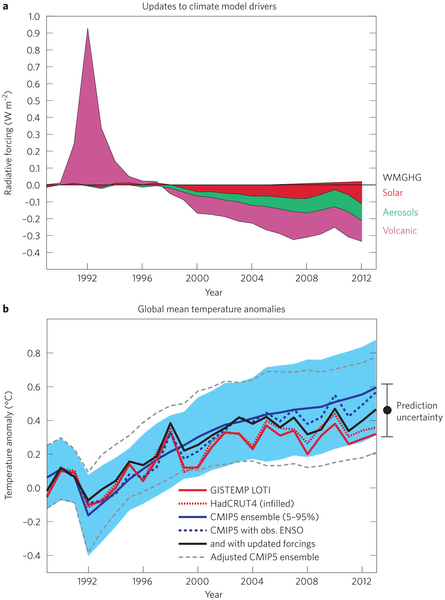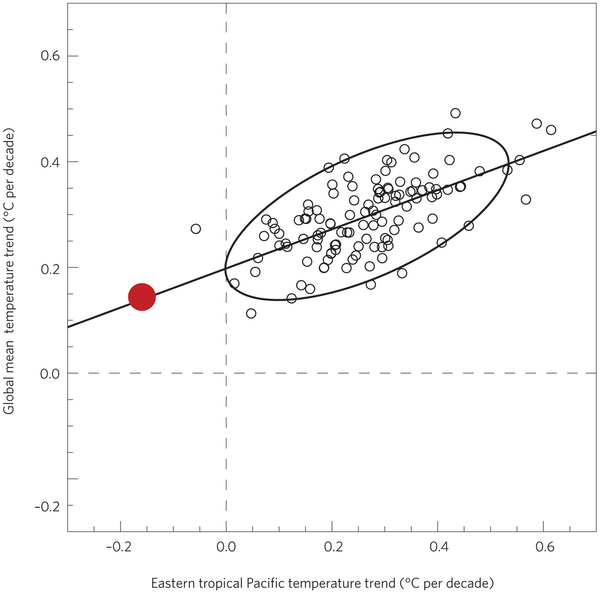It never rains but it pause
4 min read
RealClimate –
There has been a veritable deluge of new papers this month related to recent trends in surface temperature. There are analyses of the CMIP5 ensemble, new model runs, analyses of complementary observational data, attempts at reconciliation all the way to commentaries on how the topic has been covered in the media and on twitter. We will attempt to bring the highlights together here. As background, it is worth reading our previous discussions, along with pieces by Simon Donner and Tamino to help put in context what is being discussed here.
The papers and commentaries address multiple aspects of recent trends: the climate drivers over recent decades, the internal variability of the system, new analyses and model-observation comparisons – much as we suggested would be the case in any discussions of model-observations mismatches last year. We will take each in turn:
Climate drivers
 Two papers (which I was an author on) are focussed mainly on examining the impact of updated forcings on the temperature: Santer et al (2014) ($) looks in detail at the impact of small volcanoes post-2000 on the vertical structure of temperature changes, while the commentary by Schmidt et al (2014) (OA, with registration) also updates the solar, aerosol and GHG forcing to estimate what the CMIP5 ensemble would have looked like if it had used this input data instead of the earlier estimates and initial forecasts (panel b in the figure).
Two papers (which I was an author on) are focussed mainly on examining the impact of updated forcings on the temperature: Santer et al (2014) ($) looks in detail at the impact of small volcanoes post-2000 on the vertical structure of temperature changes, while the commentary by Schmidt et al (2014) (OA, with registration) also updates the solar, aerosol and GHG forcing to estimate what the CMIP5 ensemble would have looked like if it had used this input data instead of the earlier estimates and initial forecasts (panel b in the figure).
Internal Variability
The contribution of internal variability to decadal trends is the focus of commentaries by Lisa Goddard (OA) and Martin Visbeck (OA). They focus on recent trends in ocean heat uptake, the Pacific Decadal Oscillation and the potential for initialised decadal predictions (such as Keenlyside et al) to capture these variations. These relate to both the earlier Kosaka and Xie and England et al papers, but are mostly reviews.
[Update: See also the Clement and DeNezio perspective in Science.]
New analyses
 Following on from Kosaka and Xie, Fyfe and Gillett (2014) ($) show that the trends in the Eastern Pacific (1993-2012) are well outside the spread in the CMIP5 ensemble (see figure on right). This is consistent with England et al results, and yet it is unclear to what extent mis-specifications in the forcing might have affected it. For instance, if the updates to volcanic forcings from Vernier et al and used in the Santer and Schmidt papers are correct, trends from 1993 (at the maximum post-Pinatubo cooling) will be too large.
Following on from Kosaka and Xie, Fyfe and Gillett (2014) ($) show that the trends in the Eastern Pacific (1993-2012) are well outside the spread in the CMIP5 ensemble (see figure on right). This is consistent with England et al results, and yet it is unclear to what extent mis-specifications in the forcing might have affected it. For instance, if the updates to volcanic forcings from Vernier et al and used in the Santer and Schmidt papers are correct, trends from 1993 (at the maximum post-Pinatubo cooling) will be too large.
As the Nature Geoscience editorial emphasizes, there is more to climate change than the global mean temperature anomaly, and the paper by Seneviratne et al ($) shows that trends in extreme temperatures over land have continued apace throughout this time period.
Media, outreach and editorial response
Finally, there are some commentaries that look at the impact these questions have had on the wider public discussion: Hawkins et al (OA, including Twitter stalwarts Tamsin Edwards and Doug McNeall) discuss the opportunities that interest in recent trends gives scientists to discuss science on social media (also blogged about here), while Max Boykoff (OA) focuses on the framing of the issue in traditional media. Both Nature Clim. Chg. (OA) and Nature Geoscience (OA) have interesting editorials.
Overall, this is a great set of overviews of the issues – observations, comparisons, and modelling – and leads to some very specific directions for future research. There is unlikely to be any pause in that.
References
B.D. Santer, C. Bonfils, J.F. Painter, M.D. Zelinka, C. Mears, S. Solomon, G.A. Schmidt, J.C. Fyfe, J.N.S. Cole, L. Nazarenko, K.E. Taylor, and F.J. Wentz, “Volcanic contribution to decadal changes in tropospheric temperature”, Nature Geosci, vol. 7, pp. 185-189, 2014. https://dx.doi.org/10.1038/ngeo2098
G.A. Schmidt, D.T. Shindell, and K. Tsigaridis, “Reconciling warming trends”, Nature Geosci, vol. 7, pp. 158-160, 2014. https://dx.doi.org/10.1038/ngeo2105
L. Goddard, “Heat hide and seek”, Nature Climate change, vol. 4, pp. 158-161, 2014. https://dx.doi.org/10.1038/nclimate2155
M. Visbeck, “Bumpy path to a warmer world”, Nature Geosci, vol. 7, pp. 160-161, 2014. https://dx.doi.org/10.1038/ngeo2104
A. Clement, and P. DiNezio, “The Tropical Pacific Ocean–Back in the Driver’s Seat?”, Science, vol. 343, pp. 976-978, 2014. https://dx.doi.org/10.1126/science.1248115
J.C. Fyfe, and N.P. Gillett, “Recent observed and simulated warming”, Nature Climate change, vol. 4, pp. 150-151, 2014. https://dx.doi.org/10.1038/nclimate2111
“Hiatus in context”, Nature Geosci, vol. 7, pp. 157-157, 2014. https://dx.doi.org/10.1038/ngeo2116
S.I. Seneviratne, M.G. Donat, B. Mueller, and L.V. Alexander, “No pause in the increase of hot temperature extremes”, Nature Climate change, vol. 4, pp. 161-163, 2014. https://dx.doi.org/10.1038/nclimate2145
E. Hawkins, T. Edwards, and D. McNeall, “Pause for thought”, Nature Climate change, vol. 4, pp. 154-156, 2014. https://dx.doi.org/10.1038/nclimate2150
M.T. Boykoff, “Media discourse on the climate slowdown”, Nature Climate change, vol. 4, pp. 156-158, 2014. https://dx.doi.org/10.1038/nclimate2156
“Scientist communicators”, Nature Climate change, vol. 4, pp. 149-149, 2014. https://dx.doi.org/10.1038/nclimate2167
(c) RealClimate – Read entire story here.




